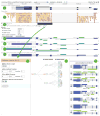NGS analyses by visualization with Trackster
- PMID: 23138293
- PMCID: PMC3889118
- DOI: 10.1038/nbt.2404
NGS analyses by visualization with Trackster
Figures


References
Publication types
MeSH terms
Grants and funding
LinkOut - more resources
Full Text Sources

